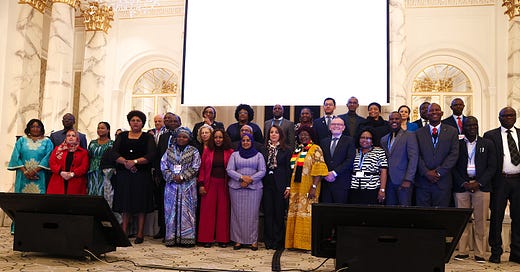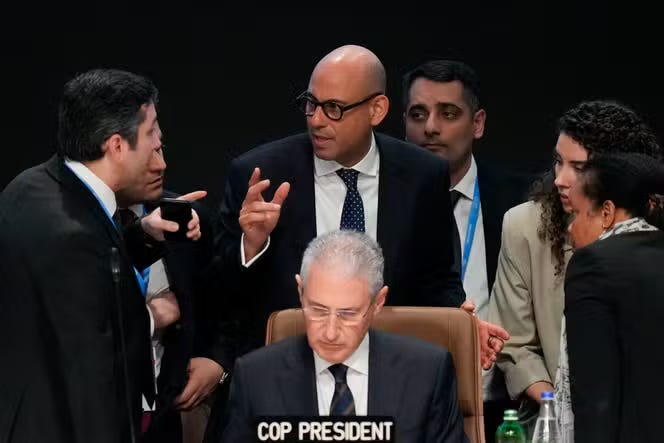Last week, the usually tranquil Baku (the capital of Azerbaijan) found itself at the center of a global costume party. Important people from around the world descended on the city, flaunting their finest traditional attire. The Africans and Asians turned up the style dial to "Technicolor Spectacle," leaving the Europeans and North Americans sulking in their grey and black suits. Alas, this wasn’t an international fashion show. No, this was the annual pilgrimage of world leaders to the Conference of Parties (or COP for those who like their acronyms). The theme? Climate Change. Once a year, these leaders are struck by an epiphany: “OMG! Glaciers are melting in Antarctica! Spain is flooding! Islands are disappearing! California is on fire! Something must be done!” They convene, they pose for group photos, they exchange solemn nods of agreement, they adjourn to hearty meals and draft declarations full of "urgent" actions.
After a week of handshakes and downing multiple milkshakes, the leaders pack up their lofty promises and head home, returning to business as usual. Occasionally, though, the stars align, and the COP produces an agreement that’s actually bold (in 2015 when COP met at Paris, they signed an agreement that goes by an unoriginal name ‘Paris Accord’).
This year, at the COP in 2024, the world waited with bated breath to see if this would be one of those rare moments—or just another chapter in the grand tradition of climate theater. As it turned out, there was some drama and then there was silence.
Every week, on the Lighter Side, I write about one news story that I find fascinating and interesting. This week’s story is about the theatre and drama that unfolded at the COP29 in Baku whose grand finale put many Disney movies’ climaxes to shame. No Prince Charming arose to save the day.
A short walk back in history - let’s begin with the Paris Accord
After years of negotiations and debates, a group of world leaders gathered in Paris in December 2015 for that year’s COP and signed a historic agreement. This landmark deal committed all countries to do all they can to limit global temperature rise to below 2 degrees Celsius. It also included a promise from wealthy nations to fund poorer ones, so they could invest in renewable energy and other measures to cut carbon emissions.
Remember, rich countries had spent decades filling the atmosphere with carbon as they built grand factories. These same factories were the ones that helped them grow rich in the first place. The poor ones, on the other hand, left their forests intact, had hardly had any factories to speak of, and the farmers followed good old practices to grow food. Thanks to all of these, they stayed poor.
Fast forward to 2015. These same poorer countries, despite causing the LEAST harm, were the first to bear the brunt of climate disasters like floods and heatwaves.

In 2015, at the COP that met in Paris, the rich nations found themselves cornered. They were expected to pony up some cash—let’s call it “pocket change”—to help the poor ones cope. Of course, this wasn’t just about charity. It was about survival, because when the planet starts to spiral, no amount of wealth can stop rising seas or scorching winds.
As then-U.S. President Barack Obama put it, “The growing threat of climate change could define the contours of this century more than any other. Many poor nations have contributed very little to climate change, but they will be the first to face its effects.”
In December 2015, optimism filled the air as more than 200 countries got together and pledged positive action. People were going back home to think of wonderful ways of keeping the world pretty and green.
Then, in 2016, a new man took over the White House—a man who thought all this talk of climate change was hogwash and nonsense. Enter Donald Trump. He announced the U.S. was pulling out of the Paris Accord. Under Trump’s administration, federal lands were opened for expanded oil and gas drilling, and environmental evaluation was to be taken lightly. His mantra? “Drill, baby, drill!”
By 2020, the tides shifted again. The US had a new president - a man who was deeply concerned about melting glaciers, dying whales, and raging wildfires. His name was Joe Biden. He declared that the U.S. would rejoin the Paris Accord. At the next COP, he enthusiastically proclaimed that America was back in the fight against climate change.
And now, Trump is back as President-elect of the US. Safe to say, no one in Baku was holding their breath for America to save the day at this year’s COP. The world has collectively shrugged and said, “Yeah, we’re not counting on you to fix this mess.” After all, when the captain keeps abandoning ship, who’s going to trust him to steer it?

2015 to 2024: What was going on in another corner of the world - China
In 2015, China had a serious problem with air pollution. In the middle of the day, cities like Beijing were plunged into eerie darkness, thanks to smog. It felt like living inside a coal-powered snow globe. The Chinese leadership began to realize this wasn’t a good look for the self-proclaimed "rising superpower."
Now, China has a knack for throwing vast sums of money at problems it deems worth solving. And unlike democracies where decision-making involves endless debates and opposition, the Chinese Communist Party (CCP) has enjoyed over 80 years of uninterrupted rule. Translation? When the CCP decides to do something, it’s not up for discussion. No pesky debates, no rival parties slowing things down—just one decision and an entire nation marching to the same beat.
Fortunately for China (and, frankly, the planet), President Xi Jinping saw the electric vehicle industry as the light at the end of the smog-filled tunnel. He ordered that outdated, polluting factories had to be replaced by cleaner technologies. China began building solar panels and wind turbines at a MASSIVE scale. It made other nations’ efforts look like weekend science projects.
Did you know that China makes about 60% of all the electric cars in the entire world? Meanwhile, the US—big, important, look-at-me US—manages to produce a modest 10%. It’s like a race where China’s zooming ahead in a fancy electric car, and the US is still trying to find its keys.
About 30% of China’s electricity comes from renewable energy (solar / wind etc.) The US? Less than 20%.
But here’s the real jaw-dropper: China’s carbon emissions HAVE ALREADY peaked. What this means is that starting next year, they’ll actually produce less pollution every year—even though their factories and industries will keep growing like crazy. How? They’re planning to build even MORE renewable energy sources to power all that growth. So, while other countries are scratching their heads, China’s playing the long game: “Let’s grow bigger and cleaner at the same time!”
Coming back to NOW - at Baku - COP 2024
Remember how I told you the rich countries promised to help the poor ones deal with all the floods and wildfires they didn’t cause? Well, here’s the twist: the poor countries sat down, took out their pencils and did their math, and said, “We’ll need about $6 trillion to fix this mess.” The rich countries? Oh, they nearly choked on their pancakes. “Six trillion?!” they scoffed. “That’s absurd!” So, with great fanfare, they announced they’d give… a measly $100 billion a year. You know, just enough to buy a few buckets to bail out those floods.
The poor countries (fancy folks call them the Global South), led by India, weren’t having it. They stormed out in protest, which made the rich countries panic and say, “Wait, wait, let’s talk again!” After another round of negotiations, the poor reduced their ask to $1.3 trillion. The rich, feeling oh-so-generous, said, “Great! Since you’ve lowered your number, we’ll raise ours… to $300 billion a year!” Math isn’t their strong suit.
Meanwhile, China has gone back to building wind turbines and solar panels like a boss. The US has returned to its favorite pastime: drilling for oil and gas. And the poor countries, dressed in their brightest festive outfits and armed with a spirit of “The rich are clueless and will never change,” have hopped on their planes and have flown back home. Another year, another climate circus!
Podcast this week
Heard of ‘The Lion, the Witch and the Wardrobe’? The legendary book that is part of the Chronicles of Narnia? We got some young readers together to speak on a podcast, on what they liked, and disliked about the book. Want to find out more about this book? Click below to listen to the podcast.
Recommended reads for you
A primary schooler in Ireland did not get a medal when she went on stage - all because she was BLACK. She refused to accept this without a fight. Read the story of how she got an apology and her medal.
New Year’s around the corner and it’s often a fancy time to create fancy goals. There are traditions around the world that make New Year’s celebration a lot more meaningful. Read here to find out about three of them - Japan, Brazil and Latin America
Traveling is one of the greatest joys in life. But it can also lead to a lot of waste generation (you know the tiny shampoo bottles and the paper cups we drink from). Read here to find out how you can travel responsibly to minimise waste.
Lighter Side is fueled, nourished and powered by you. As always, I would love to know your thoughts. So please do leave a comment OR click on the like button.





